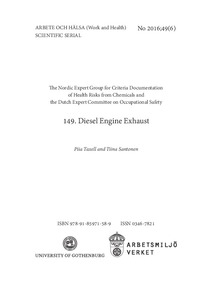The Nordic Expert Group for Criteria Documentation of Health Risks from Chemicals and the Dutch Expert Committee on Occupational Safety. 149. Diesel engine exhaust
"Diesel engine exhaust is a complex mixture of gaseous and particulate compounds produced during the combustion of diesel fuels. The gas phase includes carbon dioxide, nitrogen oxides (NOX), carbon monoxide and small amounts of sulphur dioxide and various organic compounds. Diesel exhaust parti...
| Main Authors: | , |
|---|---|
| Institution: | ETUI-European Trade Union Institute |
| Format: | TEXT |
| Language: | English |
| Published: |
Gothenburg
2016
University of Gothenburg |
| Subjects: | |
| Online Access: | https://www.labourline.org/KENTIKA-091212481949-The-Nordic-expert-Group-for-Cr.htm |
| Summary: | "Diesel engine exhaust is a complex mixture of gaseous and particulate compounds produced during the combustion of diesel fuels. The gas phase includes carbon dioxide, nitrogen oxides (NOX), carbon monoxide and small amounts of sulphur dioxide and various organic compounds. Diesel exhaust particles (DEP) contain elemental carbon (EC), organic compounds, sulphates, nitrates and trace amounts of metals and other elements. New technology diesel engines are characterised by a significant reduction of the DEP mass emissions. Occupational exposure to diesel exhaust occurs in mining, construction work, professional driving, agri-culture and other activities where diesel-powered vehicles and tools are applied. The critical health effects of diesel exhaust are considered to be pulmonary inflammation and lung cancer. For older technology diesel engines, pulmonary inflammatory responses were observed in human volunteers after single exposure at 100
g DEP/m3 (~ 75
g EC/m3), and in rats after long-term exposure at 210
g DEP/m3 (~ 160
g EC/m3). Development of lung tumours was seen in rats at 2 200
g DEP/m3 (~ 1 650
g EC/m3). For new technology diesel engines, pulmonary inflammatory changes were reported in rats after 13 and 130 weeks of exposure at 3.6 and 4.2 ppm NO2 (12–13
g DEP/m3, ~ 3
g EC/m3). The effect was absent at 0.9–1.0 ppm NO2 (4–5
g DEP/m3, ~ 1
g EC/m3). No indication of tumour development was detected. Epidemiological studies associate occupational exposure to exhaust from older technology diesel engines with increased lung cancer risk. Based on a log-linear meta-regression model, 45 years of occupational exposure to diesel exhaust at 1, 10 and 25
g EC/m3 was estimated to result in 17, 200 and 689 extra lung cancer deaths per 10 000 individuals, respectively, by the age of 80 years. Although data allowing a direct comparison of the carcinogenic potential of exhaust from new and older technology diesel engines are not available, the significant reduction of the DEP mass concentration in the new technology diesel engine exhaust is expected to reduce the lung cancer risk (per kWh). In addition to the critical effects, human and animal inhalation studies associate exposure to older technology diesel engine exhaust with sensory irritation, increased airway resistance, cardiovascular effects, genotoxicity and adjuvant allergenic effects. There are also animal studies indicating neuroinflammatory effects, developmental effects and effects on the male reproductive function. When evaluating the health risk of diesel exhausts it is important to take into account that the transition from “old” to “new” technology diesel engines is expected to take a long time. Keywords: cancer, cardiovascular, diesel engine, diesel exhaust, elemental carbon, inflammation, nitrogen dioxide, occupational exposure limit, particles, pulmonary, review, risk assessment, toxicity." |
|---|---|
| Physical Description: | 147 p. Digital |

